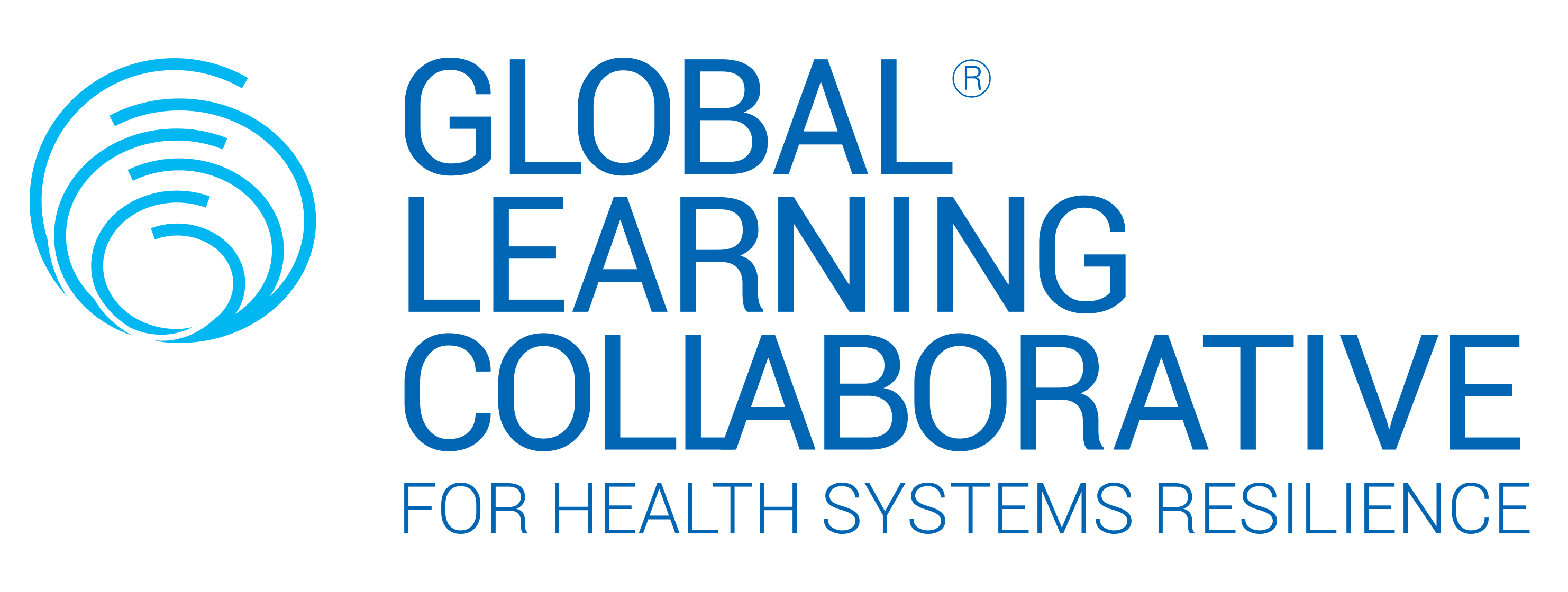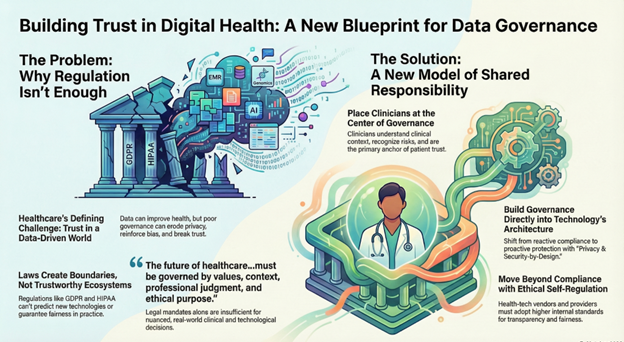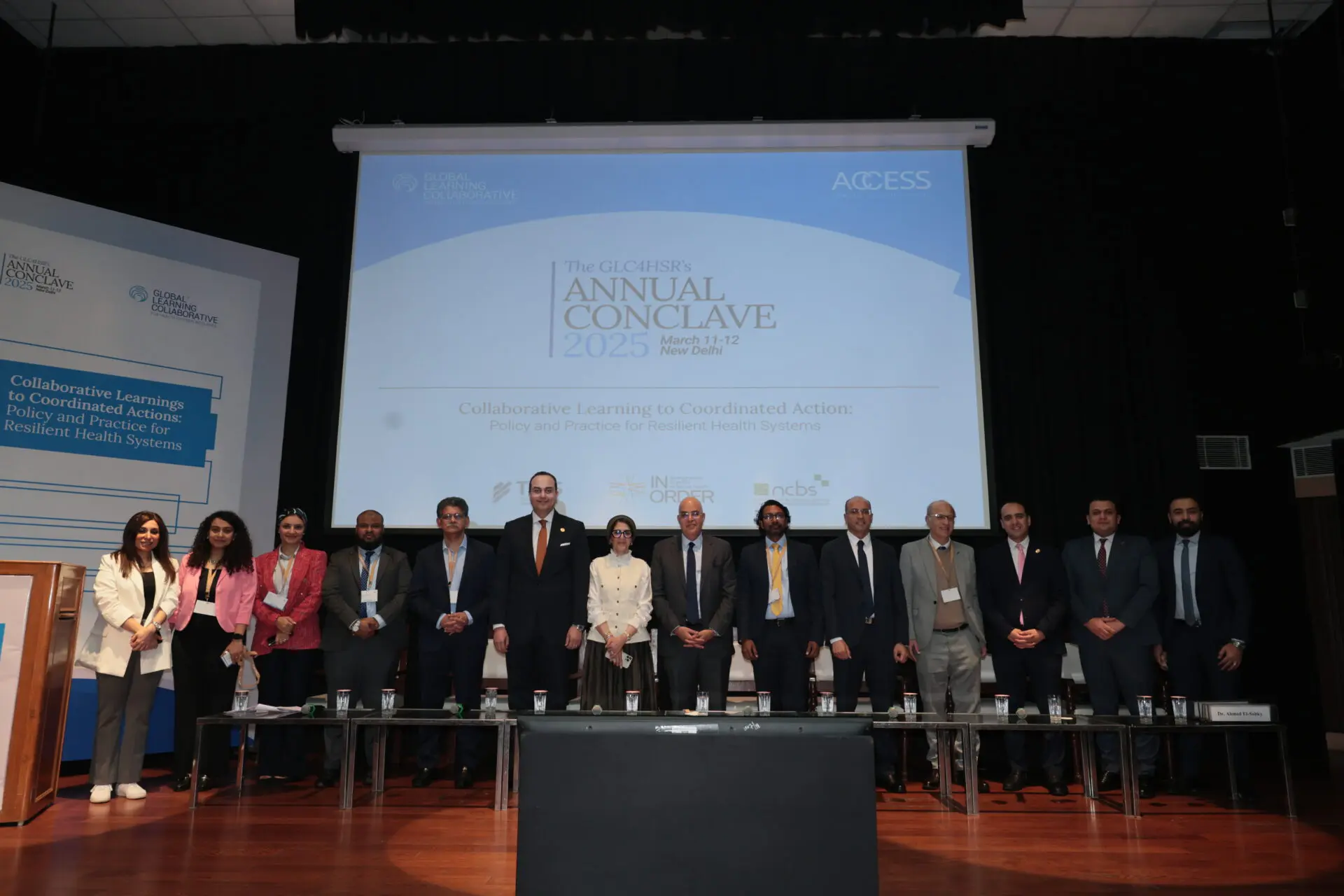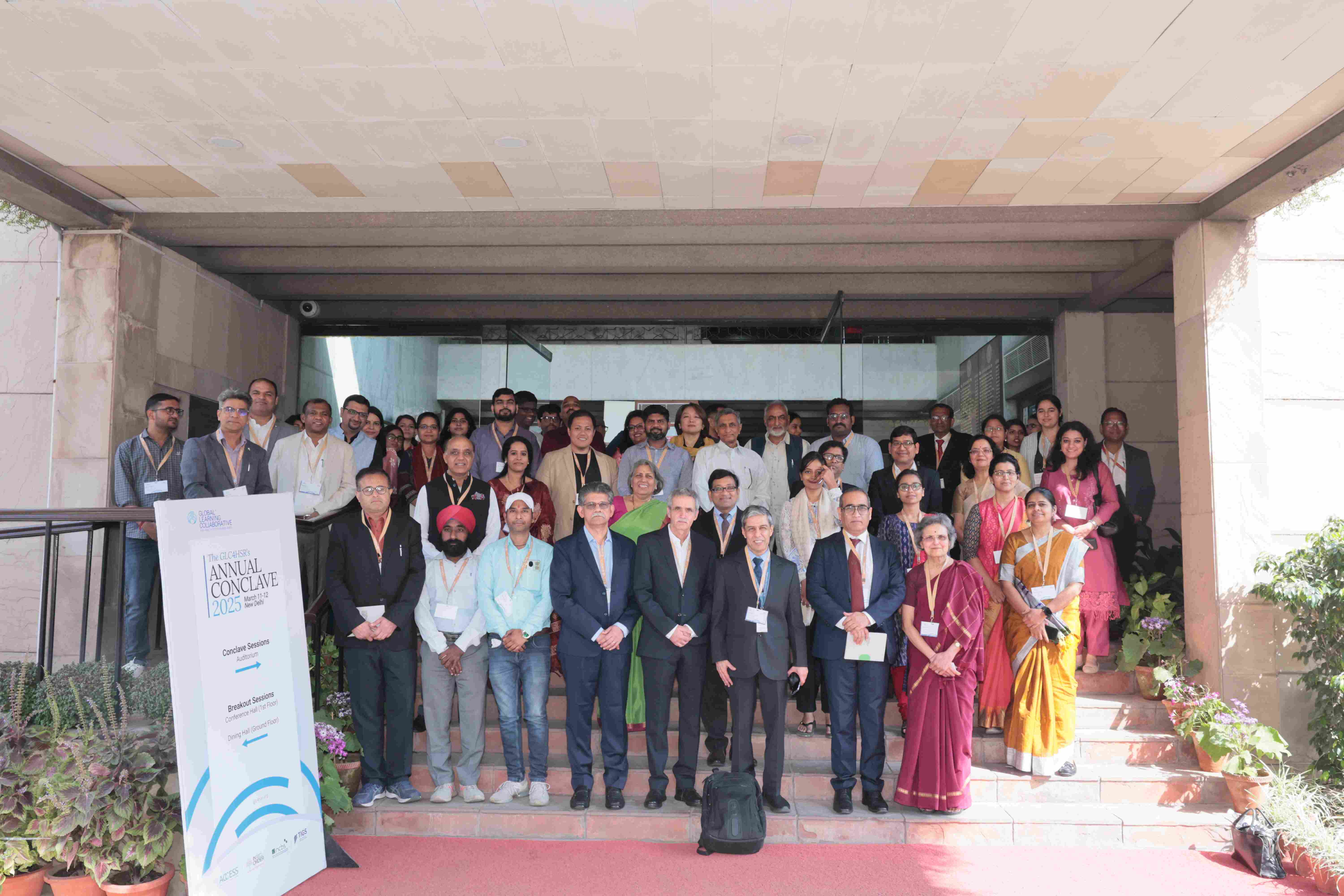OPINION: Community health systems resilience in a “One Health” paradigm
Opinion Pieces ▪ Jan 8, 2024
-Dr. Vijay Yeldandi
Introduction
The traditional approach to health policy has been a top-down approach, often criticized as being paternalistic, condescending, often male chauvinist, non-contextual, and therefore inherently flawed. Such policies are prescriptive and inflexible, and use rigid evaluation frameworks of “desired” outcomes based on “a –priori” assumptions. Health is a complex adaptive system1 and policies that are reductionist in design and implementation have been less than satisfactory.2
Health policy design and implementation need to be participatory and adaptive, with iterative policy improvements factoring in emerging outcomes being an inherent part of the process.3,4 Here we discuss an example of control of Rabies in India in a “One Health” framework. We also propose that strategies of participatory action that are adaptive are key to community engagement. Such engagement lays the foundation for sustainability which is imperative for building resilience in health systems. A combination of a bottom-up approach rooted in the community defining the goal and the metrics being used, linked to adaptive external support through public health systems and non-governmental entities is essential. A key component of such a system is substantial ownership of the community in financial planning as well as governance.
Engaging the community
All too often engaging the community is a one-time activity that may provide a “feel good” glow to the principal activists but does not necessarily lead to sustainability once the intervention has ceased. Resilience requires both ownership and sustainability for which resources, both tangible and intangible, are required. Let us consider a couple of examples from history:
- The story of raw milk:
In 1892 Lina Straus and her husband Nathan Straus (a Jewish immigrant from Germany whose family migrated to USA in 1854) founded the Nathan Straus Pasteurized Milk Laboratory to provide pasteurized milk to children. Straus was convinced that milk from infected cows was a source of tuberculosis in children. His own cow had died and autopsy demonstrated pulmonary tuberculosis, later his son died of pneumonia and pericarditis (possibly tuberculosis). It is estimated that the Nathan Straus Pasteurized Milk Laboratory supplied free pasteurized milk to 297 milk stations in 36 cities. This initiative saved 445,800 vulnerable children. Nevertheless, despite incontrovertible evidence of the benefit of pasteurizing milk, the first city to require pasteurization of milk was Chicago in 1908.5,6,7,8 Even today in California it is legal to sell unpasteurized raw milk (a warning on the package is required). This practice of consuming unpasteurized milk in the USA has been linked to multiple outbreaks of serious infections and mortality in the last 20 years.9
- The story of toilets:
In the last two decades, India has focused greater attention on the provision of toilets as an essential measure of improving public health through sanitation. Even as investments in building toilets ramped up, a change in behavior and cessation of the practice of open defecation emerged as a challenge.10 A campaign to have community buy-in became imperative.11,12,13 Despite all of the progress made and the report of the Government of India that 95.4% of households have and use toilets,14 toilets in India remain quantitatively and qualitatively far from desirable, in public toilets on roads; public hospitals, and railways. Could we have had greater success through better design? Should public toilets be merely functional? Is a beautiful toilet a mere luxury? Consider the experience of Laura Orlando in 2007 working with Grupo Ecológico Zayab-Ha, with some support from RILES, building more than 60 beautiful compost toilets called Nahi Xix in Chemax, Mexico in a poor Mayan community.
Not only did the toilets become a source of pride for the women, there was also a completely unplanned outcome. The NGO Zayab-Ha (members of the community) through their ongoing engagement with the community established a new NGO Kiimac Koolel Ool managed by women in the community. Eventually with the support of the government a women’s center and shelter “Tumben Kuxtal” was created ultimately contributing positively to the social fabric in many ways. 15
Rabies control: An example of the “One Health” approach
Rabies in India
Rabies, an acute progressive viral encephalomyelitis with a severe case fatality ratio, is one of the most significant infectious diseases. This zoonosis, due to viruses in the genus Lyssavirus that perpetuate among mammals (predominantly from the Carnivora and Chiroptera orders) worldwide, causes >55,000 human deaths, tens of millions of human exposures, and substantial animal losses annually. Most cases occur in Asia (~55%) and Africa (~45%), where canine rabies is enzootic. Costs for prevention and control activities are prohibitively high for developing countries. The Ministries of Health and Family Welfare (MoHFW) and Agriculture and Farmer’s Welfare (MoAFW) indicate that major rabies reservoirs are dogs, with greater than 90% of cases diagnosed in this species. Over 90% of human rabies post-exposure prophylaxis (PEP) cases are attributable to dog bites. Other animals constitute a smaller proportion of cases, all secondary to rabid dogs. Clearly, this is a problem of non-reporting (as are the human rabies cases). A majority of cases are diagnosed based on clinical signs only.16
Feral canine population in India
In the past 50 years, feral dog populations have seen a substantial increase despite control programs. 17,18 Clearly apart from the obvious risk of human bites and rabies there is also a substantial threat to other wildlife and ecologic damage. 19,20 In a community based study we observed co-location of feral dogs near human habitats and litter and garbage (unpublished data). Others have noted similar interactions between food sources and dog populations. 21
Dog bites in India
In our small study we noted a number of dog bites not related to pets. (unpublished data). A ‘One Health’ approach to the control of feral dog populations would be to ensure humane treatment of all dogs as well controlling the environmental sources of food for feral dogs. 22,23
First response to dog bites
First response to dog bites has to integrate wound management (washing the wound with copious amounts of soap water reduces the risk of infection substantially) and providing prompt post exposure vaccination and where indicated rabies immune globulin 24 to the victim of the dog bite. Anecdotally we have seen rather ill-advised practices in the management of dog-bites as well as other animal (monkey, rat, bats) bites, this is particularly true of rural areas where animal bites have been treated with hot irons, lucky charms and other “magical spells” with advice for fasting. We await results from a recent study in which we have participated. 25,26
Current practice of rabies vaccination
In India there appears to be considerable variation in access to rabies immune globulin and human rabies vaccine particularly in rural areas, a considerable variation in the practice of intradermal vs intramuscular vaccines including variations in the frequency of administration is seen. A part of this maybe the significant logistical/financial burden of lower socio-economic strata in rural areas. There is a need for improvement in canine vaccination. 27
Oral canine rabies vaccine
In India, in particular, vaccination of pet dogs as well feral dogs has presented numerous difficulties ranging from less than optimal adherence to vaccination of pets as well as (understandable) reluctance of municipal workers to implement traditional canine vaccination for feral dogs. For several decades now, oral rabies vaccines have been available and used extensively in North Americas and Europe. Oral rabies vaccine for dogs should be explored further in India. 28, 29,30
The One Health approach to Rabies control
At multiple sites throughout the world including developing middle income countries the “One Health” approach to rabies control has demonstrated considerable success as compared to older strategies. This has included control of dog populations, vaccination of dogs and an integrated approach to the management of animal bites in humans. 31-41 One state in India has demonstrated commendable success in adopting canine rabies vaccine integrated into a “One Health” approach to rabies control, resulting in a 92% reduction in monthly canine rabies cases. 42
A systems approach integrating “One Health and One Planet” for health systems resilience
The concept of "Health" has evolved, with various existing definitions focusing primarily on the biomedical aspects. However, there is growing recognition that health is a complex interplay of multiple factors, extending beyond the absence of disease. As the examples of the story of “Raw Milk” and “Rabies Control” demonstrate, ignoring community engagement is the “Achilles Heel” of any public health policy design and implementation. Clearly, design and implementation of health policy must be a dynamic continuum that is adaptive. In our experience, an upfront investment in building meaningful relationships anchored in social justice using the paradigm of “Salutogenesis”59and the “Meikirch model” is a prerequisite.
The Meikirch model1 offers a comprehensive definition of health as a dynamic state of well-being that encompasses physical, mental, and social potential, enabling individuals to meet the demands of life based on their age, culture, and personal responsibility. In this model, health is not solely a physical description but also involves fulfilling the diverse demands of life through inherent and acquired potential within a social and cultural context. To simplify, individuals striving for health must address six key parameters: biologically given potential, personally acquired potential, demands of life, personal responsibility for health, age, and culture.
The healthcare sector is unique among the service industries in that it is the provider rather than the consumer who has the dominant influence over the quantity and, indeed, the quality of the product delivered. Increasingly, democratic societies demand more significant influence on the quantity and quality of services provided, and the healthcare sector is no exception. The answers may be in exploration that fosters the evolution of appropriate paradigms and eventual ownership of the goals, methodology, and metrics for advancing human health anchored in social justice. We believe that the evolution of such a system necessarily requires an intensive involvement of the community in every facet of the design of their own "Health" goals and metrics. We must develop relevant methodologies to collaborate effectively with the community and create knowledge and systems with broad applications in population health globally. In engaging with the community we believe that we must exploit newer digital technologies for improving health literacy of the community as well improve our own understanding of geographic, temporal, cultural dimensions of the community perspective of health using tools such as photovoice. 43-58
Finally, “Resilient Health Systems” must integrate a grass roots level ownership of all facets of health linked to a responsive resource system with sufficient reserves and a dynamic adaptive policy design and implementation laying the foundation for an autocatalytic; autopoietic system delivering a purposeful life with autonomy and dignity for all. 60
References:
- Bircher J and Hahn EG. Applying a complex adaptive system's understanding of health to primary care F1000 Research , 5 :1672 12 Jul 2016, 5:1672 (doi:10.12688/f1000research.9042.1)
- A bias for Hope: Luca Meldolesi and Nicolea Stame, eds. A COLORNI-HIRSCHMAN INTERNATIONAL INSTITUTE & INDEPENDENT EVALUATION GROUP - WORLD BANK GROUP. World Bank, Washington DC, October 25-26, 2017
- Conversations Worth Having: Using Appreciative Inquiry to Fuel Productive and Meaningful Engagement by Jackie Stavros, Cheri Torres, David L. Cooperrider. Published by Berrett-Koehler Publishers. May 22, 2018. ISBN: 9781523094035
- PDIA toolkit. A DIY Approach to Solving Complex Problems. Version 1.0 published in October 2018. Editors: Salimah Samji, Matt Andrews, Lant Pritchett and Michael Woolcock. Open access publication, available online and distributed under the terms of a Creative Commons Attribution –Non Commercial –No Derivatives 4.0 International license (CC BY-NC-ND 4.0), a copy of which is available athttp://creativecommons.org/licenses/by-nc-nd/4.0/
- Disease in Milk: The Remedy, Pasteurization,Lina Gutherz Straus, Nathan Straus, 1913. Digitized from Harvard University Library. Available online, Digital Archive.
- "The Milk Man" by John Steele Gordon, Philanthropy Roundtable. Reprint of fall 2011 issue of Philanthropy Magazine.philanthropyroundtable.org
- 7. "Nathan Straus" by David de Sola Pool in 1931-32 AJC.American Jewish Committee Archives.com
- https://en.wikipedia.org/wiki/Nathan_Straus
- Costard S, Espejo L, Groenendaal H, Zagmutt FJ. Outbreak-Related Disease Burden Associated with Consumption of Unpasteurized Cow's Milk and Cheese, United States, 2009-2014. Emerg Infect Dis. 2017 Jun;23(6):957-964. doi: 10.3201/eid2306.151603. PMID: 28518026; PMCID: PMC5443421.
- https://www.youtube.com/watch?v=ffp8HyHQGsU
- https://www.youtube.com/watch?v=zAFu70gSO8M
- https://www.youtube.com/watch?v=S5ZqdOp2aoU
- https://www.youtube.com/watch?v=sJUI_FnFoLg
- https://www.pib.gov.in/PressReleasePage.aspx?PRID=1907510
- Laura Orlando “Reflections of a Sanitarian” Page 133-143. A bias for Hope: Luca Meldolesi and Nicolea Stame, eds. A COLORNI-HIRSCHMAN INTERNATIONAL INSTITUTE & INDEPENDENT EVALUATION GROUP - WORLD BANK GROUP. World Bank, Washington DC, October 25-26, 2017
- https://www.who.int/news-room/fact-sheets/detail/rabies
- Smith LM, Hartmann S, Munteanu AM, Dalla Villa P, Quinnell RJ, Collins LM. The Effectiveness of Dog Population Management: A Systematic Review. Animals (Basel). 2019 Nov 22;9(12):1020. doi: 10.3390/ani9121020. PMID: 31766746; PMCID: PMC6940938.
- Belsare, A., Vanak, A.T. Modelling the challenges of managing free-ranging dog populations. Sci Rep 10, 18874 (2020). https://doi.org/10.1038/s41598-020-75828-6
- https://www.wildlifeconservationtrust.org/feral-dogs-vs-wildlife-a-human-made-disaster-in-the-making/
- Pushpakumara N, Dangolla A, Perera O. Ecology of Dogs in Sri Lanka and Transmission of Rabies Among Dogs and Wildlife. One Health for Dog-mediated Rabies Elimination in Asia. Published online June 29, 2023:160-173. doi:10.1079/9781800622975.0013
- de Melo SN, da Silva ES, Ribeiro RAN, Soares PHA, Cunha AKR, de Souza Gonçalves CM, Melo FDS, Horta MAP, Teixeira-Neto RG, Belo VS. The Influence of Community Feeders and Commercial Food Outlets on the Spatial Distribution of Free-Roaming Dogs-A Photographic Capture and Recapture Study. Animals (Basel). 2023 Feb 24;13(5):824. doi: 10.3390/ani13050824. PMID: 36899681; PMCID: PMC10000244.
- Islam MH, Masud MA. Investigation of Rabies Control in Free-roaming Dogs: A Mathematical Modelling Approach From Bangladesh. One Health for Dog-mediated Rabies Elimination in Asia. Published online June 29, 2023:85-98. doi:10.1079/9781800622975.0008
- Hiby E, KC P, Brum E, Hampson K. The Humane Management of Dog Populations and the Contribution to Rabies Elimination. One Health for Dog-mediated Rabies Elimination in Asia. Published online June 29, 2023:174-190. doi:10.1079/9781800622975.0014
- Quiambao BP, Dizon TJR, Grande NP, Gutierrez Miranda ME. Animal Bite Treatment Centres in the Philippines: Functions and Challenges Experienced in the Delivery of Rabies Post-exposure Prophylaxis. One Health for Dog-mediated Rabies Elimination in Asia. Published online June 29, 2023:60-73. doi:10.1079/9781800622975.0006
- “Human rabies deaths and animal bite burden in India: A cross-sectional survey” Indian Council for Medical Research. Dr. S.K.Palo, Scientist-E(PI). https://www.rmrcbbsr.gov.in/ongoing-education/
- Swedberg C, Mazeri S, Mellanby RJ, Hampson K, Chng NR. Implementing a One Health Approach to Rabies Surveillance: Lessons From Integrated Bite Case Management. Frontiers in Tropical Diseases. 2022;3. Accessed December 23, 2023. https://www.frontiersin.org/articles/10.3389/fitd.2022.829132
- Cuddington K, McAuliffe WHB. Optimizing rabies vaccination of dogs in India. Published online April 20, 2023:2023.04.10.23288318. doi:10.1101/2023.04.10.23288318
- Cliquet F, Guiot AL, Aubert M, Robardet E, Rupprecht CE, Meslin FX. Oral vaccination of dogs: a well-studied and undervalued tool for achieving human and dog rabies elimination. Veterinary Research. 2018;49(1):61. doi:10.1186/s13567-018-0554-6
- Oral vaccination of dogs against rabies: Recommendations for field application and integration into dog rabies control programmes. Accessed December 23, 2023. https://www.who.int/publications-detail-redirect/9789240082731
- Bobe K, Ortmann S, Kaiser C, et al. Efficacy of Oral Rabies Vaccine Baits Containing SPBN GASGAS in Domestic Dogs According to International Standards. Vaccines. 2023;11(2):307. doi:10.3390/vaccines11020307
- Nadal D, Slack V. Conclusions. One Health for Dog-mediated Rabies Elimination in Asia. Published online June 29, 2023:248-251. doi:10.1079/9781800622975.0020
- Jose Miranda NL, Gutierrez Miranda ME. Emerging Opportunities for Enhanced Regional One Health Approach in the Prevention, Control and Elimination of Rabies and Other Zoonoses in South-east Asia. One Health for Dog-mediated Rabies Elimination in Asia. Published online June 29, 2023:25-33. doi:10.1079/9781800622975.0003
- Balogh K de, Oh Y, Gordoncillo MJ, et al. FAO, WOAH and WHO Working Together in the Asia Pacific Region to Eliminate Dog-mediated Human Rabies by 2030. One Health for Dog-mediated Rabies Elimination in Asia. Published online June 29, 2023:11-24. doi:10.1079/9781800622975.0002
- FAO, WOAH and WHO Working Together in the Asia Pacific Region to Eliminate Dog-mediated Human Rabies by 2030. Accessed December 23, 2023. https://www.cabidigitallibrary.org/doi/epdf/10.1079/9781800622975.0002
- Nadal D, Radhakrishnan S. Global Dog and Human Rabies Control Efforts from Ancient Times to 2030 and Beyond. One Health for Dog-mediated Rabies Elimination in Asia. Published online June 29, 2023:1-10. doi:10.1079/9781800622975.0001
- Petsophonsakul W, Inoue S. One Health Approach to Control Canine Rabies in Thailand: The Chiang Mai Model. One Health for Dog-mediated Rabies Elimination in Asia. Published online June 29, 2023:34-46. doi:10.1079/9781800622975.0004
- Fitzpatrick MC, Shah HA, Pandey A, et al. One Health approach to cost-effective rabies control in India. Proceedings of the National Academy of Sciences. 2016;113(51):14574-14581. doi:10.1073/pnas.1604975113
- Nadal D, Beeching S, Cleaveland S, et al. Rabies and the pandemic: lessons for One Health. Transactions of The Royal Society of Tropical Medicine and Hygiene. 2022;116(3):197-200. doi:10.1093/trstmh/trab123
- Communication. Rabies control: A model for one health collaboration - WOAH. WOAH - World Organisation for Animal Health. Published September 27, 2022. Accessed December 23, 2023. https://www.woah.org/en/rabies-control-a-model-for-one-health-collaboration/
- Yale G, Lopes M, Isloor S, et al. Review of oral rabies vaccination of dogs and its application in India. Viruses. 2022;14(1):155. doi:10.3390/v14010155
- Tidman R, Thumbi S, Wallace R, et al. United Against Rabies Forum: The One Health Concept at Work. Frontiers in Public Health. 2022;10. Accessed December 23, 2023.https://www.frontiersin.org/articles/10.3389/fpubh.2022.854419
- Gibson AD, Yale G, Corfmat J, et al. Elimination of human rabies in Goa, India through an integrated One Health approach. Nat Commun. 2022;13(1):2788. doi:10.1038/s41467-022-30371-y
- Pyo J, Lee H, Kang Y, Oh J, Ock M. A participatory practice study for the improvement of sub-regional health vulnerabilities: a qualitative study. BMC Public Health. 2022;22(1):1698. doi:10.1186/s12889-022-14111-x
- Anderson K, Elder-Robinson E, Howard K, Garvey G. A Systematic Methods Review of Photovoice Research with Indigenous Young People. International Journal of Qualitative Methods. 2023;22:16094069231172076. doi:10.1177/16094069231172076
- Elers P, Elers S, Dutta MJ, Torres R. Applying the Culture-Centered Approach to visual storytelling methods. Review of Communication. 2021;21(1):33-43. doi:10.1080/15358593.2021.1895292
- Journal of Social Studies Education Research » Submission » Using Digital Participatory Research to Foster Glocal Competence; Constructing Multimedia Projects as a Form of Global and Civic Citizenship. Accessed December 23, 2023. https://dergipark.org.tr/en/pub/jsser/issue/26846/282296
- Methods Vignettes: Photovoice. STEPS Centre. Accessed December 23, 2023. https://steps-centre.org/pathways-methods-vignettes/methods-vignettes-photovoice/
- Castleden H, Garvin T, First Nation H ay aht. Modifying Photovoice for community-based participatory Indigenous research. Social Science & Medicine. 2008;66(6):1393-1405. doi:10.1016/j.socscimed.2007.11.030
- Mayfield-Johnson S, Butler III J. Moving from Pictures to Social Action: An Introduction to Photovoice as a Participatory Action Tool. New Directions for Adult and Continuing Education. 2017;2017(154):49-59. doi:10.1002/ace.20230
- Lu AJ, Sannon S, Moy C, et al. Participatory Noticing through Photovoice: Engaging Arts- and Community-Based Approaches in Design Research. In: Proceedings of the 2023 ACM Designing Interactive Systems Conference. DIS ’23. Association for Computing Machinery; 2023:2489-2508. doi:10.1145/3563657.3596041
- Budig K, Diez J, Conde P, Sastre M, Hernán M, Franco M. Photovoice and empowerment: evaluating the transformative potential of a participatory action research project. BMC Public Health. 2018;18(1):432. doi:10.1186/s12889-018-5335-7
- Photovoice and the Impact on Life in Marginalized Communities. University of Nevada, Reno. Published June 3, 2019. Accessed December 23, 2023. https://onlinedegrees.unr.edu/blog/photovoice-and-the-impact-on-life-in-marginalized-communities/
- Nykiforuk CIJ, Vallianatos H, Nieuwendyk LM. Photovoice as a Method for Revealing Community Perceptions of the Built and Social Environment. Int J Qual Methods. 2011;10(2):103-124.
- Hergenrather K, Rhodes S, Cowan C, Bardhoshi G, Pula S. Photovoice as Community-Based Participatory Research: A Qualitative Review. American journal of health behavior. 2009;33:686-698. doi:10.5993/AJHB.33.6.6
- Becker K, Reiser M, Lambert S, Covello C. Photovoice: Conducting Community-Based Participatory Research and Advocacy in Mental Health. Journal of Creativity in Mental Health. 2014;9(2):188-209. doi:10.1080/15401383.2014.890088
- Bisung E, Elliott SJ, Abudho B, Karanja DM, Schuster-Wallace CJ. Using Photovoice as a Community Based Participatory Research Tool for Changing Water, Sanitation, and Hygiene Behaviours in Usoma, Kenya. Biomed Res Int. 2015;2015:903025. doi:10.1155/2015/903025
- Dempsey JS. Using Photovoice as a Community-Based Participatory Research Method to Identify Perceived Risk and Protective Factors for Depression in Rural Adolescents. International Journal of Nursing & Clinical Practices. 2016;2016. doi:10.15344/2394-4978/2016/194
- Schurer JM, McKenzie C, Okemow C, Viveros-Guzmán A, Beatch H, Jenkins EJ. Who Let the Dogs Out? Communicating First Nations Perspectives on a Canine Veterinary Intervention Through Digital Storytelling. EcoHealth. 2015;12(4):592-601. doi:10.1007/s10393-015-1055-y
- Contextualizing salutogenesis and Antonovsky in public health development. BENGT LINDSTROM and MONICA ERIKSSON, Folkhalsan Research Center, Health Promotion Programme, Paasikivenkatu 4, FIN-00250 Helsinki, Finland and Folkhalsan Research Center, Health Promotion Programme, Paasikivenkatu 4, FIN-00250 Helsinki, Finland. Health Promotion International, Vol. 21 No. 3 doi:10.1093/heapro/dal016 Advance access publication 22 May 2006.
- www.happenforonehealth.org






